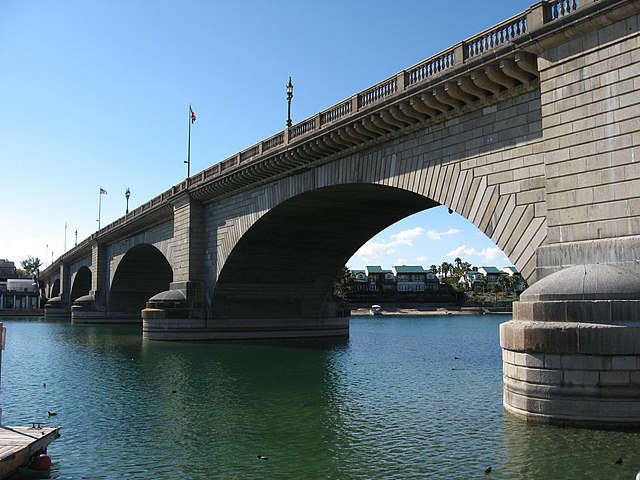
How did London Bridge end up in America? London Bridge ended up in Arizona, America because it was bought by an industrialist called Robert McCulloch who bought it and shipped it over the Atlantic.
The London Bridges that is in America was built in 1831 and it was sold by the City of London in 1968. It was shipped to Arizona and the finished bridge was opened in 1971. This London Bridge wasn’t the first bridge to cross the Thames in London, and it wasn’t the last. It also wasn’t the most famous London Bridge and there was a rumor at the time that McCulloch thought he was buying a different bridge, but that wasn’t true. McCulloch visited the bridge before he decided to buy it and signed all of the paperwork in London.
The very first bridge across the Thames at London was built by the Romans in 43 AD. Before that, the river could be forded at places upstream. It was only when the Romans arrived that London became large enough to need a bridge and the very first one was a pontoon bridge made of boats. Wooden bridges don’t last very long and it was replaced over the years as the city grew. The first stone bridge was built in 1209. It was fairly wide and it had a drawbridge in the middle to allow sailing ships through. The city continued to grow and people built houses and shops on the bridge. It was crowded and very difficult for horse-drawn carriages to pass. There were also several fires on the bridge. In 1657, all of the houses were torn down and the bridge was widened to let in more traffic.
The first stone London Bridge lasted for over 600 years. By 1821, the amount of traffic going across the bridge had increased drastically and become heavier as well. The city council realized that a new bridge was called for and they had a Scottish engineer called John Rennie design it. The bridge was built just downriver from the 600-year-old stone bridge so that there was still a bridge during construction. When it was completed in 1831, the old London Bridge was dismantled.
The new London Bridge was perfect, except for one small problem. John Rennie had designed a perfect bridge, but he obviously had no way of knowing that the future traffic over the bridge would consist of very heavy cars and trucks. The vehicles weighed more, they could carry more cargo, and they passed much more frequently. The excess weight made the bridge sink into the riverbed at a rate of 4 mm a year. That doesn’t sound like a lot, but by 1924, the east side of the bridge was 12 cm lower than the west. That is not good for the structural integrity of a bridge. The bridge survived through World War 2, but by the 1960s a new bridge was desperately needed. Plans were drawn up for a modern bridge that would be strong enough to cope with the traffic. The question was, what should we do with the old bridge?
A city councilor called Ivan Luckin wondered if they might be able to sell the bridge to cover the enormous cost of dismantling it. He was an advertising executive before he became a councilor, and he had a lot of experience of selling. He sailed to America and embarked on a campaign to sell the bridge. The only person who seemed seriously interested was Robert McCulloch. He was a wealthy industrialist, and he had just bought 16,353 acres of land in Arizona, and he had founded a town called Lake Havasu City. He wanted the town to grow, and he wanted tourists, but he had no idea how to accomplish it until he heard about the London Bridge sale. He bought the bridge for $2,460,000, which is $22,128,890 today.
Once he’d bought the bridge, he had to get it to Arizona. He also had to make a river for it to span. He had a canal dug from the nearby lake, creating an island on his land for the bridge, Then, the bridge was taken apart and a large part of the granite and all of the outer bricks were shipped to the states. Every brick was numbered so that they would know exactly where they went. The ship went via the Panama Canal. Once it arrived, the bridge was reconstructed, but McCulloch didn’t want the same problem that London had had, so he ordered a modern steel-reinforced concrete bridge to be built, and then the granite and bricks from London Bridge were laid around it. The bricks went back on in exactly the right order and the finished product looked just like the original bridge. Many people said McCulloch had made a stupid decision and wasted his money, but the bridge brings in roughly two million tourists a year and the population of Lake Havasu City is 57,144 people as of today. London Bridge in Arizona is the second largest tourist destination after the Grand Canyon! And that is what I learned today.
Sources
https://www.history.com/news/how-london-bridge-ended-up-in-arizona
https://en.wikipedia.org/wiki/London_Bridge_(Lake_Havasu_City)
https://en.wikipedia.org/wiki/Lake_Havasu_City,_Arizona
Image By Ken Lund from Las Vegas, Nevada, USA – London Bridge, Lake Havasu City, ArizonaUploaded by LongLiveRock, CC BY-SA 2.0, https://commons.wikimedia.org/w/index.php?curid=9696374

Pingback: #504 What cause rigor mortis?
Pingback: #707 Why are bridges designed to move?
Pingback: #767 When did Britain become an island?